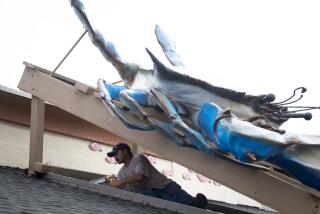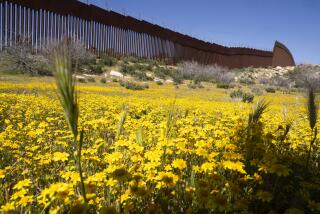Wildlife rescue effort is a challenge in the gulf
- Share via
Reporting from Pass-a-Loutre, La. — The small boat approached four pelicans perched on a rusty platform emerging from the flat green waters of the Gulf of Mexico on this steaming hot and windless day. They peered down their long beaks at the vessel. Then, as if teasing the humans spying on them through binoculars, two of the birds spread their wings and soared away just as the boat drew near.
But two remained behind, and they were the ones wildlife biologist Haven Barnhill eyed with concern. Earlier that morning, with the nation’s worst-ever oil spill gushing uncontained for the sixth week, Barnhill had found a dead pelican in these waters, its feathers slick with oil, its life lost to a slow creep of poison.
The biologist stood silently, taking in the scene. Far in the distance, huge oil rigs rose like giant Lego toys from the water. “There’s a potential when they don’t fly that there might be something keeping them there,” he said.
The pair suddenly took flight, showing they were healthy but offering little relief to wildlife experts like Barnhill, who knows that as he combs one spot searching for dead or ailing wildlife, the oil is moving elsewhere, oozing into marshland and onto sandy barrier islands, and staining waters along the Gulf Coast.
“I certainly believe this has the potential to be a huge ecological disaster,” said Barnhill, one of about three dozen people stationed on a houseboat about 35 miles off Louisiana’s southeastern tip.
Each morning, wildlife teams deploy from here to scour the region, using information gleaned from satellite images of the oil slick, knowledge of bird colonies’ expected locations, and from reports at a central command center of possible wildlife in distress. They are among an army of hundreds, from state, federal and environmental organizations, spread out across the gulf.
At night, the workers input their findings into a data system to steer their search efforts. Bird, fish and reptile tallies appear on colorful charts, and the latest oil sightings are quickly mapped for morning deployments.
There was nothing like this in 1989, when the Exxon Valdez spill sent 11 million gallons of oil into Prince William Sound in Alaska, said Rowan Gould, the acting director of the Fish and Wildlife Service. Gould took part in the Exxon Valdez cleanup, and he went along this week in a boat that shadowed Barnhill’s.
But technology has its limits here, where the search is brutally challenging: The temperature soars into the 90s, even 40 miles out to sea. The expanse covers tens of thousands of square miles of open water. Impressive satellite imagery helps narrow the search field, yet the effort still comes down to a biologist spotting a small, flailing victim through binoculars.
In Prince William Sound, Gould said, rescue workers arrived to find “birds as far as the eye could see,” spread out before them like white carpets. The heavy crude oil from that spill was easy to spot and quickly weighed down the wildlife, making animals easy to catch for cleaning and rehabilitation.
This time, the oil is lighter in weight and color. Some wildlife can function, for awhile at least, if soiled. That makes it hard to determine which animals should be caught. Once captured, the creatures must be hurriedly sent to a rehabilitation center on land to avoid becoming overheated. And because it is difficult for searchers to blanket such a huge area — the waters closed to fishing alone cover 76,000 square miles — scavengers probably are devouring some affected animals before they can be rescued.
So far, the number of captured or dead fish, birds, mammals and reptiles seems low in relation to the amount of oil that has spilled: On Wednesday the tally included 522 birds, with an additional 82 rescued. Searchers had found 228 dead sea turtles and 29 dead mammals, including dolphins. Most creatures did not show obvious signs of being in contact with oil, but it is possible they were affected in ways not immediately visible.
Wildlife experts fear the numbers belie the scope of the toll. The reeds and bayous prove perfect hiding spots for wildlife that might be ailing. Also, biologists suspect that dead wildlife is probably sinking at sea.
“It’s nice to protect the birds, but it’s the whole ecosystem that’s critical,” Barnhill said.
“It’s the basis for the food chain. It’s also the basis for this whole community,” he added, gesturing toward the fishermen whose businesses leading charter trips has given way to taking wildlife searchers about.
Lou J. Domino Jr., 55, who has worked on the water since he was 14, is one of them. He drove the boat that carried Gould. Domino navigated a maze of small bays and waterways with names like Lonesome Bayou and Dead Woman Pass.
“I honestly believe we have a catastrophe to deal with, and resources are very limited,” said Domino, whose sunburned face speaks to his years as a fisherman. “We’re fighting a war in Afghanistan, and we have soldiers in Iraq. We just came through Katrina,” he said, describing the fear of gulf residents that their lives have been irrevocably changed by this.
No more motoring into the water and catching your own shrimp for dinner. No more summers ferrying vacationing fishermen out to sea to reel in snapper.
Barnhill’s boat stopped near a wooden platform laden with orange-beaked royal terns. With the boat engines cut, the only sound was from the terns’ cries. Normally, Barnhill said, he would not expect to find the birds nesting in this spot, so he wondered whether they were stranded.
A noise sent the birds flying off in unison, like a white cloud lifting into the air. Barnhill moved on, further into the gulf, where small boats dragging oil booms occasionally passed and where all the pelicans he approached the rest of the afternoon proved healthy enough to fly away.
It’s impossible to keep wildlife away from the oil as it moves, said Rhonda Murgatroyd, one of the managing directors of the wildlife rescue efforts.
“Birds know no boundaries,” she said.
More to Read
Sign up for Essential California
The most important California stories and recommendations in your inbox every morning.
You may occasionally receive promotional content from the Los Angeles Times.











